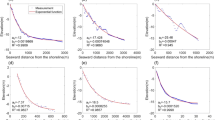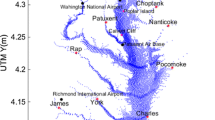Abstract
A long-term (1948–2010) shoreward energy history of upper tidal shorelines in lower Chesapeake Bay was developed using a simple calculation of kinetic energy from corresponding wind and tide data. These data were primarily used to determine the likelihood of shoreline energy increases coincident with local sea level rise. Total annual shoreward energy ranged from 620 kJ/m of shoreline in 1950 to 17,785 kJ/m of shoreline in 2009. No clear linear trends are apparent, but mean annual energy shows an increase from 2,732 kJ/m before 1982 to 6,414 kJ/m since then. This increase in mean energy was accompanied by more numerous spikes of comparatively higher annual energy. Shoreward energy delivered to lower Chesapeake Bay’s upper tidal shorelines was enabled by an increasing amount of time per year that tidal height exceeds mean high water, accompanied by increasing heights of tidal anomalies. An index termed the Hydrologic Burden was developed that incorporates the combination of time and tidal height that demonstrates this increasing trend. Although opportunities for greater shoreward energy increased as the Hydrologic Burden increased, and even though there is evidence that greater energy was delivered to the shorelines during the latter time series, energy per hour delivery was shown not to have increased, and may have decreased, due to a steady reduction in average wind speed in lower Chesapeake Bay since the mid-1980s. Energy delivery in lower Chesapeake Bay was primarily from the northeast, and energy delivery over the time series is shown to organize symmetrically around a point between the northeast and north–northeast directions. This is evidence of a self-organizational phenomenon that transcends changes in local wind and tide dynamics.





















Similar content being viewed by others
References
Austin, H.M. 2002. Decadal oscillations and regime shifts, a characterization of the Chesapeake Bay marine climate. American Fisheries Society Symposium 32: 155–170.
Boicourt, W.C. 2005. Physical response of Chesapeake Bay to hurricanes moving to the wrong side: Refining the forecasts. In Hurricane Isabel in Perspective, ed. K.G. Sellner, 39–48. CRC, New York.
Boon, J.D. 2012. Evidence of sea level acceleration at U.S. and Canadian tide stations, Atlantic Coast, North America. Journal of Coastal Research 28(6): 1437–1445.
Boon, J.D., J.M. Brubaker, and D.R. Forrest. 2010. Chesapeake Bay land subsidence and sea level change: An evaluation of past and present trends and future outlook. Special Report No. 425 in Applied Marine Science and Ocean Engineering, Virginia Institute of Marine Science. 72 p.
Bosley, K.T., and K.W. Hess. 2001. Comparison of statistical and model-based hindcasts of subtidal water levels in Chesapeake Bay. Journal of Geophysical Research 106: 16869--16885.
Chang, W., and W.C. Boicourt. 1989. Resonant seiche motion in the Chesapeake Bay. Journal of Geophysical Research 94: 2105–2110.
Cho, K., H.V. Wang, J. Shen, A. Valle-Levinson, and Y. Teng. 2012. A modeling study on the response of Chesapeake Bay to hurricane events of Floyd and Isabel. Ocean Modelling 49–50: 22–26.
Dietrich, J.C., M. Zijlema, J.J. Westerink, L.H. Holthuijsen, C. Dawson, R.A. Luettich Jr., R.E. Jensen, J.M. Smith, G.S. Stelling, and G.W. Stone. 2011. Modeling hurricane waves and storm surge using integrally-coupled, scalable computations. Coastal Engineering 58: 45–65.
Emanuel, K. 2005. Increasing destructiveness of tropical cyclones over the past 30 years. Nature 436: 686–688.
Gorman, R.M., and C.G. Neilson. 1999. Modelling shallow water wave generation and transformation in an intertidal estuary. Coastal Engineering 36: 197–217.
Graham. H.E. and D.E. Nunn. 1959. Meteorological considerations pertinent to standard Project Hurricane, Atlantic and Gulf Coasts of the United States. National Hurricane Research Project Report No. 33. U.S. Department of Commerce, Weather Bureau, Washington, D.C.
Guo, X., and A. Valle-Levinson. 2008. Wind effects on the lateral structure of density-driven circulation in Chesapeake Bay. Continental Shelf Research 28: 2450–2471.
Hsu, S.A., E.A. Meindl, and D.B. Gilhousen. 1994. Determining the power-law wind-profile exponent under near neutral stability conditions at sea. Journal of Applied Meteorology 33: 757–765.
Johnson, H.K. 1999. Simple expressions for correcting wind speed data for elevation. Coastal Engineering 36: 263–269.
Knauss, J.A. 1978. Introduction to physical oceanography. Englewood Cliffs: Prentice-Hall, Inc.
Knudsen, M.F., M.-S. Seidenkrantz, B.H. Jacobsen, and A. Kuijpers. 2011. Tracking the Atlantic multidecadal oscillation through the last 8,000 years. Nature Communications. doi:10.1038/ncomms1186.
Li, M., L. Zhong, W.C. Boicourt, S. Zhang, and D. Zhang. 2007. Hurricane-induced destratification and restratification in a partially-mixed estuary. Journal of Marine Research 65: 169–192.
Morgan, P.A., D.M. Burdick, and F.T. Short. 2009. The functions and values of fringing salt marshes in northern New England, USA. Estuaries and Coasts 32: 483–495.
NOAA. 2010. 2009 Local Climatological Data Annual Summary with Comparative Data, Norfolk Virginia (KORF). National Climate Data Center, Asheville, NC. ISSN 0198-5345.
Peng, M., L. Xie, and L.J. Pietrafesa. 2004. A numerical study of storm surge and inundation in the Croatan-Albemarle-Pamlico Estuary system. Estuarine, Coastal and Shelf Science 59: 121–137.
Rosen, P.S. 1978. A regional test of the Bruun Rule on shoreline erosion. Marine Geology 26: M7–M16.
Sallenger Jr., A.H., K.S. Doran, and P.A. Howd. 2012. Hotspot of accelerated sea-level rise on the Atlantic coast of North America. Nature Climate Change 2: 1–5.
Saville, T. 1954. "The Effect of Fetch Width on Wave Generation," Technical Memorandum 70. Washington, DC: Beach Erosion Board.
Shen, J., and W. Gong. 2009. Influence of model domain size, wind directions and Ekman transport on storm surge development inside the Chesapeake Bay: A case study of extratropical cyclone Ernesto, 2006. Journal of Marine Systems 75: 198–215.
Shen, J., H. Wang, M. Sisson, and W. Gong. 2006. Storm tide simulation in the Chesapeake Bay using an unstructured grid model. Estuarine, Coastal and Shelf Science 68: 1–16.
Stive, M.J.F., S.G.J. Aarninkhof, L. Hamm, H. Hanson, M. Larson, K.M. Wijnberg, R.J. Nicholls, and M. Capobianco. 2002. Variability of shore and shoreline evolution. Coastal Engineering 47: 211–235.
U.S. Army Corps of Engineers. 1984. Shore protection manual, vol. I. Vicksburg: Coastal Engineering Research Center.
Valle-Levinson, A., K. Wong, and K.T. Bosley. 2002. Response of the lower Chesapeake Bay to forcing from Hurricane Floyd. Continental Shelf Research 22: 1715–1729.
Villa-Concejo, A., M.G. Hughes, A.D. Short, and R. Ranasinghe. 2010. Estuarine shoreline processes in a dynamic low-energy system. Ocean Dynamics 60: 285–298.
Webster, P.J., G.J. Holland, J.A. Curry, and H. Chang. 2005. Changes in tropical cyclone number, duration, and intensity in a warming environment. Science 309: 1844–1846.
Weisberg, R.H., and L. Zheng. 2006. Hurricane storm surge simulations for Tampa Bay. Estuaries and Coasts 29(6A): 899–913.
Wong, K.A., and J.E. Moses-Hall. 1998. On the relative importance of the remote and local wind effects to the subtidal variability in a coastal plain estuary. Journal of Geophysical Research 103(c9): 18,393–18,404.
Yang, S.L., B.W. Shi, T.J. Bouma, T. Ysebaert, and X.X. Luo. 2012. Wave attenuation at a salt marsh margin: a case study of an exposed coast on the Yangtze Estuary. Estuaries and Coasts 35: 169–182.
Yin, J., M.E. Schlesinger, and R.J. Stouffer. 2009. Model projections of rapid sea-level rise on the northeast coast of the United States. Nature Geoscience 2: 262–266.
Zhong, L., and M. Li. 2006. Tidal energy fluxes and dissipation in the Chesapeake Bay. Continental Shelf Research 26: 752–770.
Zhong, L., M. Li, and M.G.G. Foreman. 2008. Resonance and sea level variability in Chesapeake Bay. Continental Shelf Research 28: 2565–2573.
Zhong, L., M. Li, and D. Zhang. 2010. How do uncertainties in hurricane model forecasts affect storm surge predictions in a semi-enclosed bay? Estuarine, Coastal and Shelf Science 90: 61–72.
Acknowledgments
I am grateful to Valerie Woodard, Donna Milligan, Scott Hardaway, Tiffany Backer, and Gary Anderson of the Virginia Institute of Marine Science for data management assistance. I am indebted to John Billet of the National Weather Service in Wakefield, Virginia and Dr. John Hoenig of the Virginia Institute of Marine Science for guidance on particular data analyses. I also thank the reviewers, whose contributions greatly improved this paper. This paper is Contribution No. 3294 of the Virginia Institute of Marine Science, The College of William and Mary.
Author information
Authors and Affiliations
Corresponding author
Additional information
Communicated by Arnoldo Valle-Levinson
Rights and permissions
About this article
Cite this article
Varnell, L.M. Shoreline Energy and Sea Level Dynamics in Lower Chesapeake Bay: History and Patterns. Estuaries and Coasts 37, 508–523 (2014). https://doi.org/10.1007/s12237-013-9672-6
Received:
Revised:
Accepted:
Published:
Issue Date:
DOI: https://doi.org/10.1007/s12237-013-9672-6




